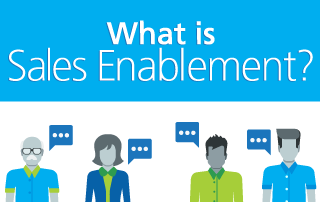George Bronten just published a fascinating post, “Your Sales Enablement Will Fail Without These 5 Things.”
I agree with him on at least 3 of the 5, and kind of sorta, but not quite agree on the 2 remaining items. But his first critical success factor really struck me, Understand Your Buyers. I absolutely agree with this–but thought, is this sufficient?
In some sense, sales is like the tail wagging the dog. We need to understand our buyers intimately, in order to engage them, and sell our solutions. But the issue of understanding the customer really has to go back much more deeply in the organization.
Understanding our customers, is at the core of the company’s business strategies and purpose. The company, not sales, must say, “who do we serve, how do we want to serve them, what do we need to have in place to serve them, how does what we do create value and demand from them?” The company, not sales, must say, “what problems are we the best in the world at solving, and who has those problems?”
This cascades into Product Development, Product Management, Product Marketing. They develop the solutions we sell. They have to be deeply embedded in understanding the customer, how and why they buy, what value we create both in using the solutions, but in engaging them with discussions about the solution. They have to make sure they are solving problems that our customers want solved, and there are enough customers that may want them solved to support our business goals and strategies.
This ripples through to customer service/customer experience. Their job isn’t just to help the customer use the product or solve problems they may be having. They have to make sure the customer is getting the most value from the product, will continue to buy, will continue to grow the relationship, and will continue to refer the product and our company to others.
I could go on, but you get the point, understanding our buyers, being able to walk in their shoes, understanding how the problems we solve helps them more effectively achieve their goals, understanding the dynamics of their customers/competitors, markets and the impact on their own strategies, understanding what might drive them to need to change, how they look at changing, how they look at buying, how they use and realize the value they expected touches virtually every part of our company.
But here’s the issue/opportunity.
Too often, the rest of the organization, yes even product development/product management, do a terrible job at doing this–at understanding the customer, at understanding the issues George poses in his blog post. Too often, they are caught in the conundrum of developing the next new product which is an evolution of the previous product, or doing nominal research on what they customer does (so they can design the product), but few really focus deeply on the customer/buyer/user.
Too often, the customer has become too abstract, they don’t really understand the customer, what drives them, their dreams, fears, goals. Often, when speaking to product managers and developers, I ask, “How many customers have you visited in the last year? How many people have you talked to? How many customers have you watched working, so you understand their problems?
Sadly, too many give poor answers. They read reports, they attend conferences, they get input (from who?), and so on. They seem to be more focused on competitors, watching them, copying them, or staying one feature or function ahead of them.
But, they don’t have an intimate understanding of the “customer.” They don’t understand the worlds our customer live in, what drives them to change, or what causes them to search/learn, or what causes them to buy. The customer is an abstraction, and sadly, secondary to their jobs of developing then next new version of the products they have always been developing.
Other parts of the company need to be as intimately knowledgeable of our customers and why/how they buy as sales and marketing. And if they are, they become very powerful in helping marketing and sales, through sales enablement, to better understand them, and the value we could create with/through them.
Unfortunately, I don’t see this happening, at least to the degree it needs to happen.
I’m not sure it’s sales enablement or sales operations, but perhaps one of the greatest values we can create, in addition to “enabling” sales people to understand the buyer, is to enable the rest of the company to understand the buyer.
Perhaps sales enablement/sales operations has an important a mission of enabling our own organization to become more customer/buyer focused. In doing this, perhaps enable these organizations to help us better equip and enable our sales teams, and by the way, our customers to succeed.
I think one of the most critical missions of the sales organization–whether we charter sales ops, sales enablement, or someone else to do this, is to sell and advocate internally. We need to make sure everyone else understands the customer and why/how they buy as intimately as we do. We need to drive an understanding of the customer, their challenges, and what we must do to engage them, and create value with them, through all parts of their problem solving, change management, buying, utilization journey.
If everyone in the organization has the same intimate understanding of our customers, and why/how they buy, we can all be much more impactful and effective.
Doing this well, helps our customers succeed, as well as each of us.

Happy to see that my post got you writing about the importance of understanding the buyer. And I completely agree with you that this understanding must be at the core of the entire company, not just the sales department. In these times of hyper-competition, it’s more important than ever!
😉 We are actually in wild agreement, but your post gave me the opportunity to start addressing some nuances.